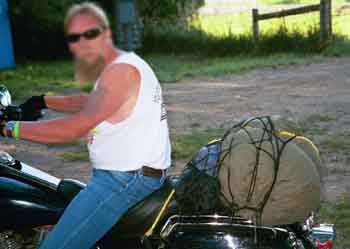
Every ride begins with a load, even if that load is just you. Add a passenger and the load goes up. However, except for a diet for you, and a rule about carrying fat chicks on your scooter, there's not much you can do about human loads.
But the rest of the stuff you carry can be managed, and ought to be managed well. Here are a few things to consider.
- Making up load itself
- Loading with respect to the bike and how it handles
- Loading with respect to weather
- Tying down the load.
- And finally, trailers (No link; not written yet, but I'll tell you now, they are a terrible idea.)
We're gonna approach this as if this were the first time you've ever packed your bike for a real trip. Once you've done it a few times, things sorta fall naturally into place, but you should always be looking for a better way to do it. Circumstances change the packing too. Maybe this time the ole lady is going along and you're staying in motels. Next time it might be just you camping out. The basic rules are the same; it's just the stuff that changes.
First of all, you have a fairly limited amount of space and load capacity, so try to think like a backpacker. Don't carry anything unless you know you're going to need it. Don't carry something heavy if you can get something light to replace it. Don't carry something bulky if you can get something compact. Don't carry something if you can pick up and dispose of something else that will do the job along the way (the best example of this is hammers; I know guys who carry hammers to pound tent pegs. I have to wonder what they think God made rocks for.) When you can, carry money instead of stuff. Money is lightweight, small, and can be turned into anything that man ever made except love. And it'll even get you a reasonable simulation of that if you have enough of it.
So first gather up all the stuff you want to take, from socks to screw drivers to sleeping bags. Put it all in a big heap out in the yard or in the garage. Don't try to sort it out yet, just look at it for now. Impressive heap, ain't it?
Go get a cup of coffee or a beer and watch a football game, or fool around with the ole lady or something for an hour or two. Come back and look at it again. Gather up and throw on the heap all the things you remembered you needed while you were watching the game.
And NOW you are ready to start the real job, that of selecting the stuff you need.
|
Tools
Look, it's nice to have a full set of tools along, but for their size, they are the heaviest things you can carry. So just carry tools that you know how to use for jobs you are prepared to do alongside the road. Don't carry a full set of sockets, |
Start by asking yourself "What must I have?" A lot of guys start out with a heap of stuff, then say "What can I get rid of." That's the wrong approach. You want to begin with what you know are the essentials, stuff you absolutely, positively, can't get by without. A guy who rides a 30-year old shovelhead, and knows how to change wheel bearings alongside the road because he's had to do it so often, is gonna have different "gotta-haves", for instance, than some guy on a new Twin Cam who has to look at the book to remember which way to loosen a bolt. You typically make underwear last a month, and you're only gonna be in the wind two weeks? Well, there shouldn't be jockeys in your stack at all, right?
OK, you've moved the "gotta have" stuff over into one pile. Throw your ole lady's "gotta have" stuff on there too. That'll take a while, 'cause a woman has a waaaay different view of "gotta have" than a man does, and you're gonna have a long discussion, maybe several discussions, with her about what goes on that heap.
Now let's say the "gotta have" heap is complete. Look at it again and make sure that there is absolutely nothing there that is not essential.



 Do not secure one piece of the load to another one, or hook one bungie cord or
strap to another up on the load. For example, don't secure your tent to the
luggage rack, then tie your sleeping bag to the tent. Every cord or strap
should hook to a solid point on the bike, or on something that is firmly
attached to the bike.
Do not secure one piece of the load to another one, or hook one bungie cord or
strap to another up on the load. For example, don't secure your tent to the
luggage rack, then tie your sleeping bag to the tent. Every cord or strap
should hook to a solid point on the bike, or on something that is firmly
attached to the bike.